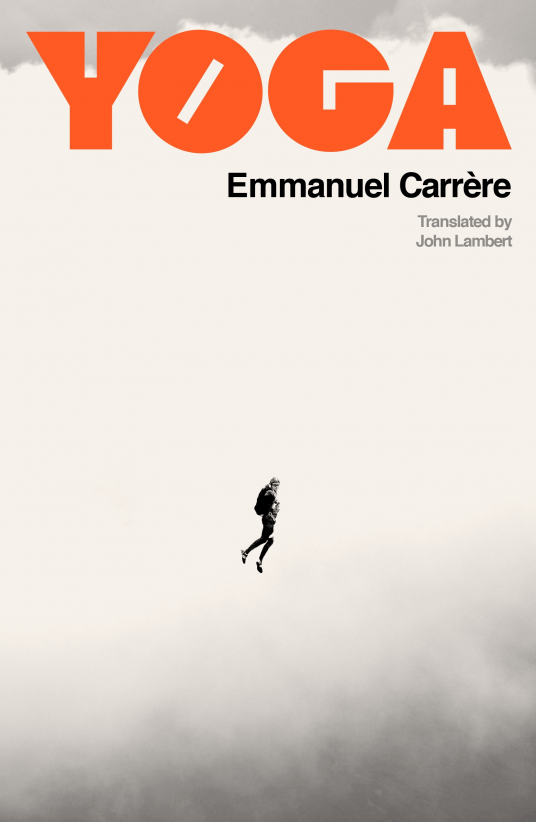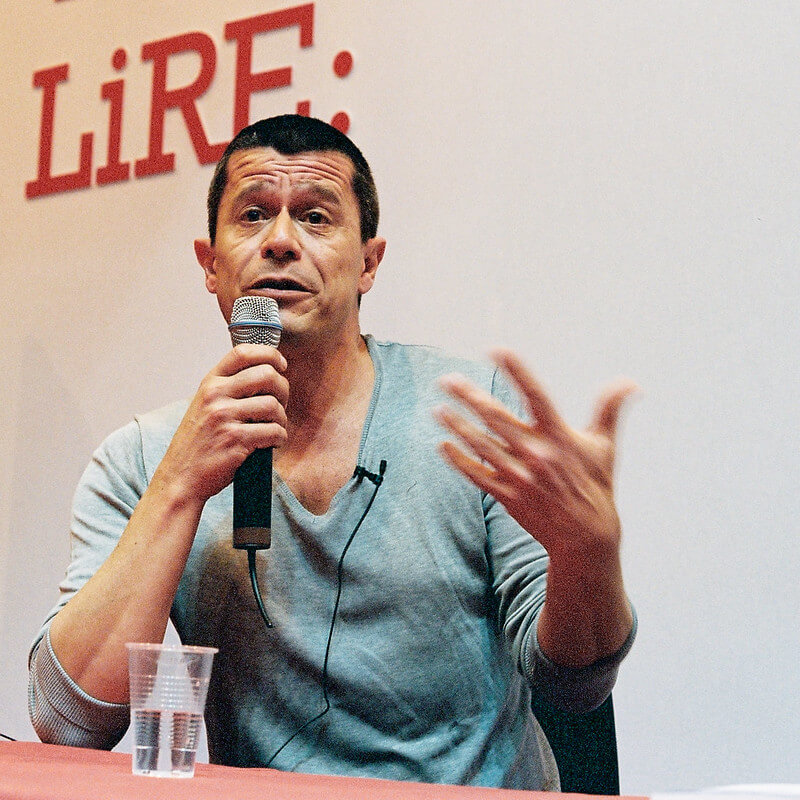Address change to reviews.pivic.com
This site is changing its address.

This is the first book by Emmanuel Carrère that I’ve read. I already knew that he’d created controversy, part of which is the reason for not writing about his ex-wife, as mandated by court order.
I also knew, before starting reading Yoga, that Carrère has written a book about Jean-Claude Romand, a man who murdered his parents, wife, and children.
I didn’t expect this to be the book that explained meditation to me.
I’ve previously learned about meditation through lectures and books on hinduism and buddhism, but never quite delved into a world that’s become meditation, where I’ve become immersed in both meditation and Carrère’s style.
Everything that happens inside you during the time you remain seated, silent and motionless, is meditation. I’ve often looked for a good definition—as simple, accurate, and all-encompassing as possible—and while there are others that I’ll unpack as this story progresses, this one seems to be the best to start off with because it’s the most concrete and the least intimidating. I repeat: meditation is everything that happens inside you during the time when you’re seated, silent and motionless. Boredom is meditation. The pains in your knees, back, and neck are meditation. The rumbling of your stomach is meditation. The feeling that you’re wasting your time with bogus spirituality is meditation. The telephone call that you prepare in your head and the desire to get up and make it are meditation. Resisting this desire is meditation—giving in to it isn’t, though, of course. That’s all. Nothing more. Anything more is too much. If you do that regularly, for ten minutes, twenty minutes, half an hour a day, then what happens during this time when you remain seated, silent and motionless, changes. Your posture changes. Your breathing changes. Your thoughts change. All of that changes because in any case everything changes, but also because you’re observing it. You don’t do anything in meditation, the key thing is not to do anything, except observe. You observe the appearance of your thoughts, your emotions, your sensations in your field of consciousness. You observe their disappearance. You observe what buoys them up, their points of reference, their convergence lines. You observe their passing. You don’t cling to them, you don’t repel them. You follow the flow without letting yourself be carried away by it. As you do that, it’s life itself that changes. At first you don’t notice. You have the vague feeling that you’re on the cusp of something. Little by little, it becomes clearer. You detach a little, just a little, from what you call yourself. A little is already a lot. It’s already enormous. It’s worth it. It’s a journey. At the start of this journey, a Zen saying goes, the distant mountain looks like a mountain. As the journey unfolds, the mountain never stops changing. You no longer recognize it, it’s replaced by a series of illusions, you no longer have any idea where you’re heading. At the end of the journey it’s a mountain once again, but it has nothing at all to do with what you saw from a distance, long ago, when you started the journey. It really is the mountain. You can finally see it. You’ve arrived. You’re there. You’re there.
We follow the author as he’s made way to a silent retreat: ten days of silence, no mobile phones, no note-taking. He breaks some rules, but still, is devoted to trying out what’s before him.
I say Carrère’s style is partly French, partly stream-of-consciousness, partly in-the-moment. It’s close to existentialism, the essay writings of Michel de Montaigne, the novels of Thomas Bernhard, the diaries of Bodil Malmsten, and the travel notes of Anthony Bourdain.
The author goes into the silent retreat with yoga and meditation experiences. Yet he doubts that he’ll make it all the way through.
Seventh definition of meditation: paying attention. The philosopher and mystic Simone Weil said that that’s the real point of studying: not to learn things—we already know enough—but to hone our skill at paying attention. The East knows more about this than the West.
Long paragraphs come into play and immediately forced me to recognise my own way of reckless thought as I’ve attempted meditation. I’ve only done it a couple of times, but I did recognise the way in which my own thoughts began to venture after a while:
The air enters my nostrils. I observe it as it enters. The air leaves my nostrils. I observe it as it leaves. It’s calm, regular. I observe how it brushes against the inside of my nasal cavity. It’s light, delicate. Nostrils have a large number of nerves, so there’s plenty to pay attention to. There’s always something happening there. You can meditate for two hours on your nostrils without getting bored. This session is off to a good start: my nostrils are my best friends. Once you’ve left the entrance and delved a little deeper into the cavities, they widen into huge caverns. The more you explore them, the farther you move along their walls, the bigger they get, and the more you feel: prickling, bristling, tingling. Pulsing, even: yes, a pulsing feeling that just about obscures all the rest. Something’s pulsing. I observe this something. I identify with this pulsing. It’s not at all unpleasant, observing it isn’t unpleasant either. It’s good. It’s good, except that my posture has slumped. Sagged. I have to straighten out, without ceasing to pay attention to my breath as it enters my nostrils or the pulsing at the back of my nasal cavity. I stretch my spine, thrusting the top of my head skyward. It’s a lot to do all at the same time, and my mind takes advantage of this congestion to slip away. My mind never stops slipping away. It slips away from the now, from the real—which is the same thing, because only what is now is real. The Tibetan master Chögyam Trungpa used to say that we dedicate 20 percent of our cerebral activity to the present. As for the remaining 80 percent, with some people it’s focused on the past, with others on the future. I, for one, spend a lot of time thinking about the future and not much about the past. Nostalgia is foreign to me. One could see that as the mark of a confident, optimistic, forward-looking person. But I fear that with me it’s more the mark of an obsessive, because while everyone knows you can’t change the past, you can always hold to the illusion that you can control the future. To keep myself from slipping down that slope, I often repeat to myself the great Jewish maxim “You want to make God laugh? Tell him about your projects.” But that doesn’t stop me from continuing to make him laugh. When God wants to lift his mood and have a good laugh, I’m sure he looks over at me, sitting on my zafu, focusing on my breathing and the inside of my nostrils while thinking about my upbeat, subtle little book on yoga. Its format, its chapters, its subheadings. I’m already thinking up sentences, wondering how many definitions of meditation I’ve got now, and it’s at this moment I realize that my thoughts have got the better of me: past, present, Chögyam Trungpa, tell God about your projects, my next book, what will be in it, how successful it will be … Time to come back to my nostrils. Time to come back to the air as it enters my nostrils. Inhale, exhale. The air is a little cooler when it enters, a little warmer when it leaves, after the long path it’s taken inside me. Outside. Inside. When is it still outside, when is it already inside? Eighth possible definition of meditation: observing the points of contact between what is oneself and what is not oneself. Between the inside and the outside, the interior and the exterior.
Carrère dips into writing about writing, in part because he’s an author, and, I suspect, in part because meditation and yoga is about introspection, how you consider every single atom and thereby going outside of yourself.
A long time ago, when I was just starting out as an author, I came across a piece of advice to apprentice writers, which I love, quoted by Freud. He cites a certain Ludwig Börne, who was a minor figure of German Romanticism. Like Glenn Gould’s maxim about the state of wonder and serenity, these words have been a sort of mantra that has accompanied me for much of my life: Take a few sheets of paper and for three days on end write down, without fabrication or hypocrisy, everything that comes into your head. Write down what you think of yourself, of your wife, of the Turkish War, of Goethe, of Fonk’s trial, of the Last Judgment, of your superiors—and when three days have passed you will be quite out of your senses with astonishment at the new and unheard-of thoughts you have had. This is the art of becoming an original writer in three days.
Writing down everything that goes through your head “without fabrication” is exactly the same as observing your breathing without modifying it. Which is to say: it’s impossible. Still, it’s worth trying. It’s worth spending your whole life trying. That’s what I do, it’s my karma, I can’t do anything else but use words to make sentences, sentences to make paragraphs, paragraphs to fill pages, pages to make chapters, and—if I’m lucky—chapters to make books. I think about it all the time. The two biggest parts of my mental pie are dedicated to thoughts about work and fantasies about sex.
While reading the book, I was often disturbed by how Carrère jumped back and forth between things, granted, as humans often do when thinking about subjects. While writing Yoga, he’s diagnosed with bipolar disorder. This goes into the book. A lot of quotes go into the book. How he thinks of sex goes into the book. The trauma of dealing with the death of friends from the so-called Charlie Hebdo massacre goes into the book as well. Everything could. Everything’s up for grabs with Carrère.
Yet, a near-masterful writer is required to not let a book like this result in sloppy deluge. Sure, I think Carrère could, at times, have pulled in the reins and cut out a bit of chaff, but on the whole, the chaff makes the wheat shine extraordinarily well; I’m not saying there’s too much fluff here, but…
There is original thought in the book. There is analysis. There’s a lot of twists and turns that made me revel and turn in wonder, time and time again. And there is chaff.
I will definitely read more of Carrère’s work, and this is likely a good introduction. As a standalone work, it’s memorable and highly subjective.
